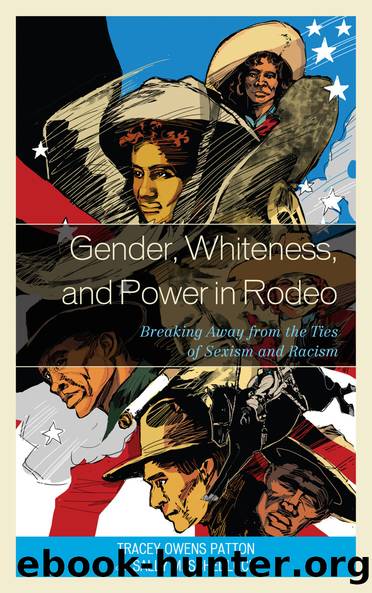Gender, Whiteness, and Power in Rodeo by Patton Tracey Owens;Schedlock Sally M.;

Author:Patton, Tracey Owens;Schedlock, Sally M.; [Patton, Tracey Owens]
Language: eng
Format: epub
Publisher: Lexington Books
Published: 2012-11-14T16:00:00+00:00
Chapter Five
Sex Kitten Cowgirl Knows Money Is in the Mane
Sex, Status, and Salaciousness
How âbout them cowgirlsBoys ainât they somthinâSure are some proud girlsAnd you canât tell them nothinâAnd I tell you right now girlsMay just be seven wonders of this big, old round worldBut how âbout them cowgirlsSheâs a ridinâ colts in Steamboat SpringsBaling hay outside AbileneSheâs trying hardTo fit in some cityBut her home is âneath that big, blue skyAnd the Northern Plains and those other wide open spacesAnd know a days there aint as manyBoy, she donât need you and she donât need meShe can do just fine on her own two feetBut she wants a man who wants her to be herselfAnd sheâll never change, donât know how to hideHer stubborn will or her fightinâ side . . . But how âbout them cowgirls.1
Capturing the essence of a cowgirl is a seemingly impossible task. George Straitâs song âHow About Them Cowgirlsâ paints the picture of a woman who is independent, fearless, self-reliant, and, above all else, true to herself. Strait captured the cowgirl as she perceives herself, but the question still on the table is how does the world perceive her? After all, cowgirls are real, but, nevertheless, the voyeuristic gaze and the objectification of her looks reinforce the myth of the cowgirl, rather than the historical reality. Google âcowgirlâ and the images that come up are titillating and mostly scandalous, of young women wearing cowboy hats and little else, in suggestive poses, or the popular barely breast-covering tee-shirts that say, âDonât call me a cowgirl until youâve seen me ride.â Then contrast the above image and clothing options with the jeans cowgirls wear, called âCruel Girlâ or âDonât Fence Me In,â made by the company called âCowgirl Tuff,â which give the cowgirl a feeling of strength, power, and freedom. The company motto for Cruel Girl exemplifies this most clearly:
In 1998, the Cruel Girl® brand was created as a premium western brand that complemented every girlâs favorite features while maintaining a dedication to an active lifestyle. . . . Cruel Girl® denim is known as a high quality, rodeo-performance, fashion-forward brand that meets the athletic demands of any sassy cowgirl. . . . A Cruel Girl® knows who she is, where she came from and is determined to get where she is going. Thereâs no denying her competitive nature either in the arena or on the battlegrounds of fashion. So arm yourself and join us! Cruel Girls possess an independent spirit and a confidence that canât be crushed.2
The aforementioned clothing options nonverbally express the dichotomous representations of popularized images of cowgirl culture. These mixed messages show the conflicted and commercialized identity of the cowgirl and cowgirl culture, as, on one hand, what culture is not commodifiable and branded to some extent? But, on the other hand, how much say do individual cultural members have in their ability to name their own experiences and control their own images? So the question arises: are these two cowgirls one and
Download
This site does not store any files on its server. We only index and link to content provided by other sites. Please contact the content providers to delete copyright contents if any and email us, we'll remove relevant links or contents immediately.
| Anthropology | Archaeology |
| Philosophy | Politics & Government |
| Social Sciences | Sociology |
| Women's Studies |
Cecilia; Or, Memoirs of an Heiress — Volume 1 by Fanny Burney(31322)
Cecilia; Or, Memoirs of an Heiress — Volume 3 by Fanny Burney(30928)
Cecilia; Or, Memoirs of an Heiress — Volume 2 by Fanny Burney(30885)
The Great Music City by Andrea Baker(21195)
We're Going to Need More Wine by Gabrielle Union(18064)
Bombshells: Glamour Girls of a Lifetime by Sullivan Steve(13100)
Pimp by Iceberg Slim(12922)
All the Missing Girls by Megan Miranda(12739)
Fifty Shades Freed by E L James(12443)
Norse Mythology by Gaiman Neil(11873)
Talking to Strangers by Malcolm Gladwell(11861)
Crazy Rich Asians by Kevin Kwan(8340)
Mindhunter: Inside the FBI's Elite Serial Crime Unit by John E. Douglas & Mark Olshaker(7827)
The Lost Art of Listening by Michael P. Nichols(6462)
Enlightenment Now: The Case for Reason, Science, Humanism, and Progress by Steven Pinker(6402)
Bad Blood by John Carreyrou(5761)
The Four Agreements by Don Miguel Ruiz(5502)
Weapons of Math Destruction by Cathy O'Neil(5029)
We Need to Talk by Celeste Headlee(4861)
